FEATURES
Still reeling from crisis, Sri Lanka holds pivotal election
Published
10 months agoon
By
editor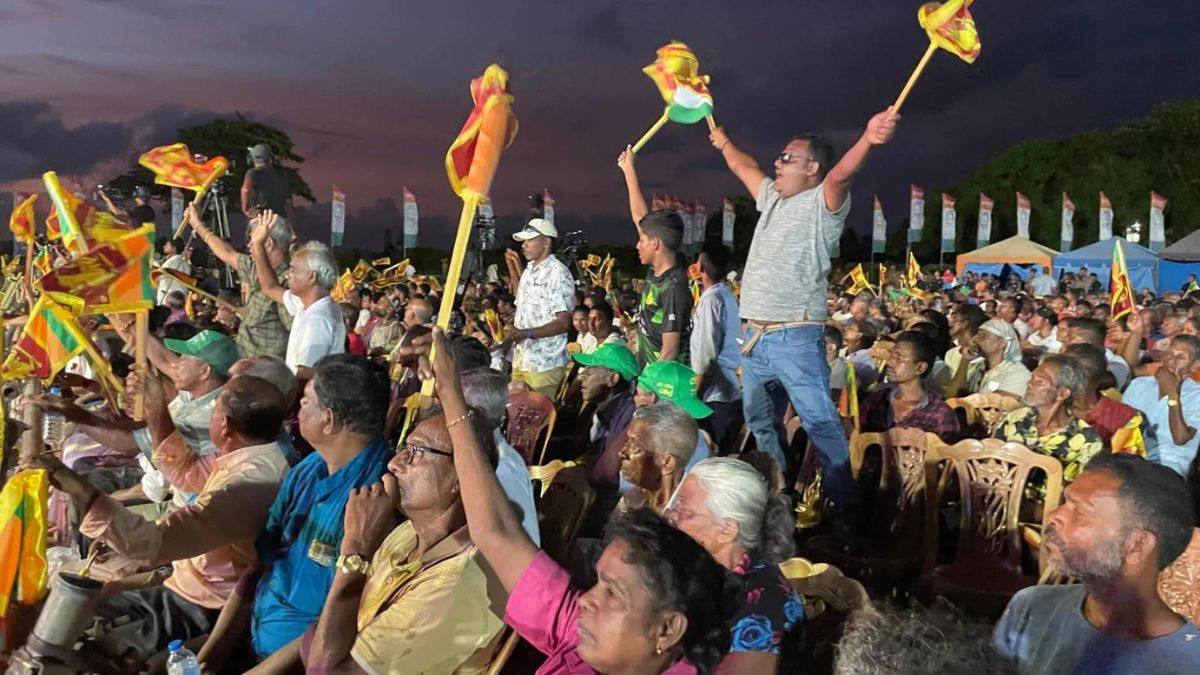
“I thought I’d spend my whole life here, fighting a corrupt government – but the younger generation did something.”
Samadhi Paramitha Brahmananayake is looking at the field where she spent months camped out with thousands of other demonstrators in Sri Lanka’s capital in 2022.
She can’t quite believe that luscious green grass has replaced the hundreds of protester tents that filled the field opposite the presidential secretariat.
“I feel we’re now more energetic, more powerful,” says Ms Brahmananayake, a 33-year-old banker based in Colombo.
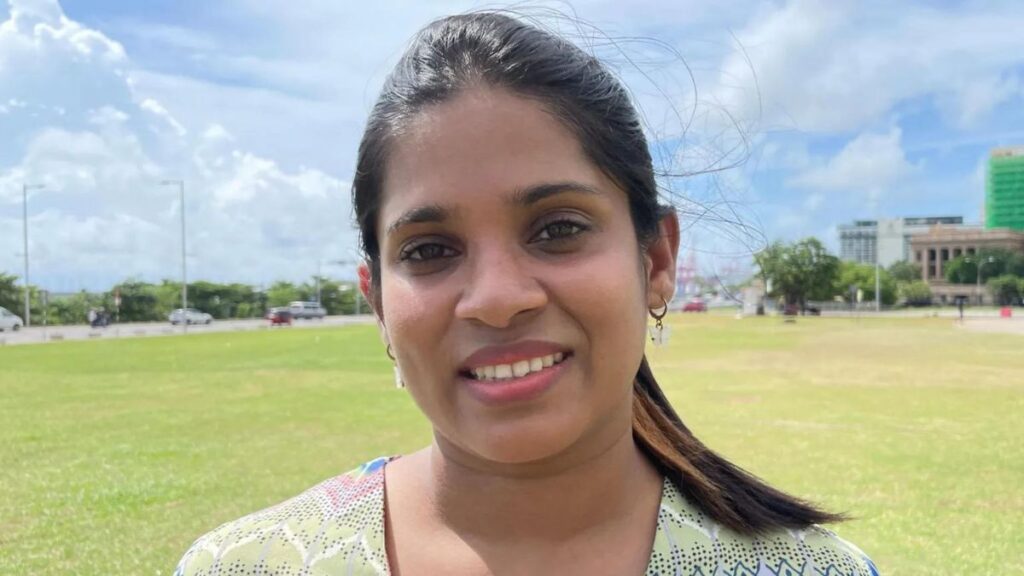
Samadhi Paramitha Brahmananayake, standing in the former tent field, feels people have power in their hands now
Two years ago, huge crowds forced the country’s deeply unpopular leader from office – now voters are just days away from choosing who they want for president.
It’s the first election since the mass protests – called the “aragalaya”, Sinhalese for struggle – which were sparked by Sri Lanka’s worst economic crisis. Inflation was at 70%. Basics like food, cooking gas and medicine were scarce.
Gotabaya Rajapaksa, the president at the time, and his government were blamed for the mess. He fled the country just before crowds stormed his residence. Euphoric protesters leapt into the presidential pool, taking victory laps.
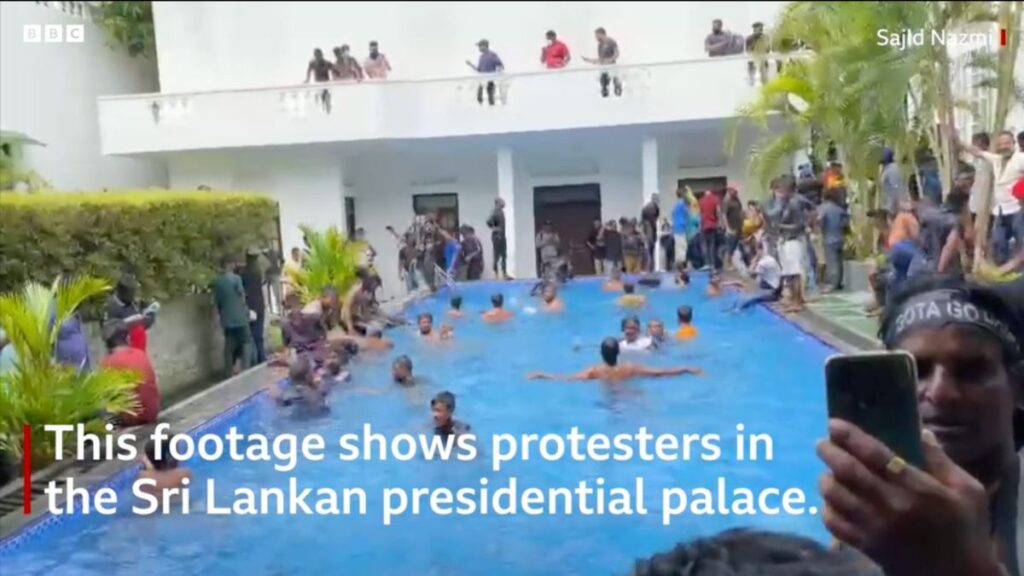
Sri Lanka crisis: Protesters swim in president’s pool
Mithun Jayawardana, 28, was one of those swimmers. “It was awesome,” he said thinking back. Jobless, with no gas or electricity at home, he says he joined the aragalaya for a lark.
Today, he recognises how crucial the elections on Saturday are: “We need a president who is elected by the people. The people didn’t elect the current president.”
Ranil Wickremesinghe, the man who currently holds the job, was appointed to the position after Gotabaya Rajapaksa resigned. Mr Wickremesinghe, who’s been tasked with steering Sri Lanka through a period of painful economic reform, is running for re-election as an independent.
He’s stood for president twice before but never succeeded, and his political future appears uncertain.
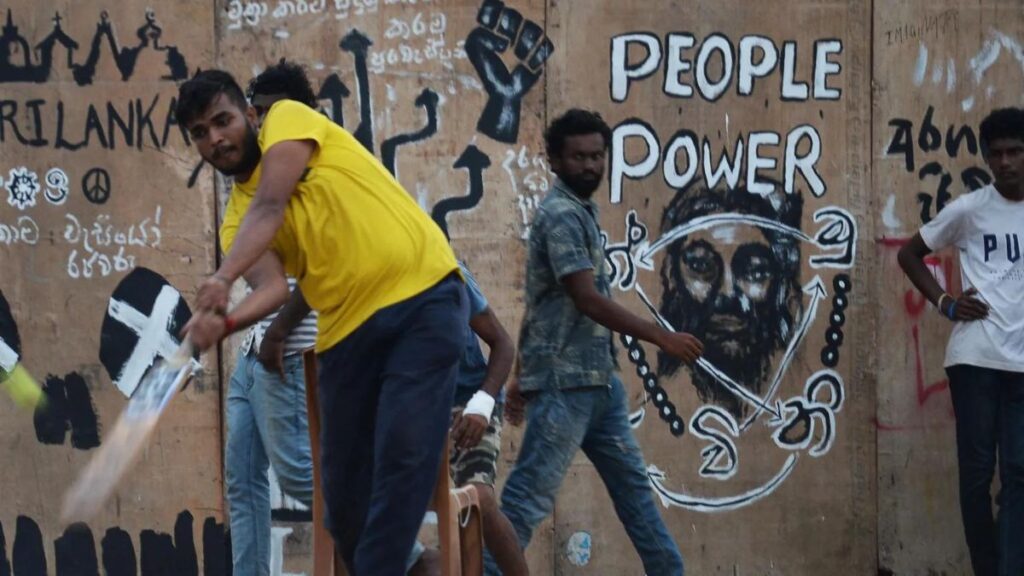
Demonstrators ran the protest camp for months – eating, sleeping and playing – until the government fell
Many associate Wickremesinghe with the Rajapaksas, a political dynasty who have dominated Sri Lankan politics for decades. Many blame them for the years of financial mismanagement that led to Sri Lanka’s economic woes.
Even the country’s top court ruled that Gotabaya Rajapaksa and his brother Mahinda, another former president, were among 13 former leaders responsible for the financial crisis.
Despite the political baggage that comes with the name, a Rajapaksa has entered the political fray in these elections – there are still places the family enjoys a lot of support.
One such district is just over an hour outside Colombo. Music, fireworks and the cheers of supporters greeted Namal Rajapaksa as he approached the podium to address the hundreds that had come to hear him speak on Monday in the town of Minuwangoda. Even his father, Mahinda joined him on stage.
Namal Rajapaksa denied his family’s role in Sri Lanka’s economic collapse.
“We know our hands are clean, we know we have not done anything wrong to the people or this country,” he told the BBC.
“We are willing to face the people, let the public decide what they want and who to vote for.”
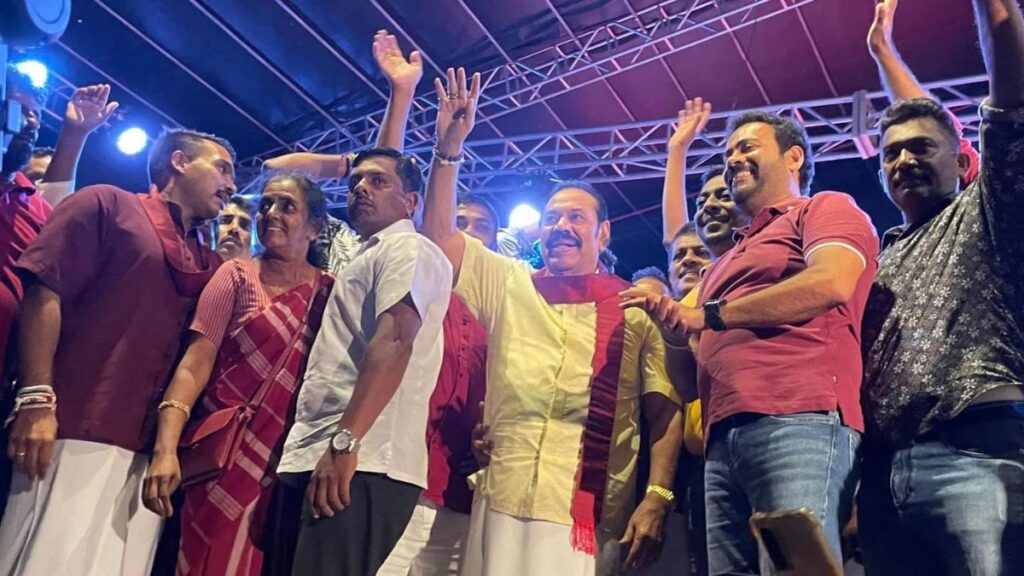
Namal Rajapaksa (far left) and his father (centre) at a rally near Colombo – they reject the accusations against the family
In all, a record 38 candidates are contesting the 21 September election, none of them women. In 2019, Sajid Premadasa, leader of the country’s main opposition party, won 42% of the popular vote, losing to Gotabaya Rajapaksa. This time around he is thought to be in with a chance too.
For people looking for change, many are looking to Anura Kumara Dissanayake. The candidate of the leftist National People’s Party alliance has emerged as an unlikely frontrunner.
Thousands of people flocked to a field in the small town of Mirigama, two hours north-west from Colombo, to hear Mr Dissanayake speak last Saturday, many wearing bright pink hats or T-shirts with his face.
“Yes 100% sure, okay,” he tells the BBC, when asked if he can win. Campaigning as the voice of the working class, he is hoping to disrupt Sri Lanka’s political establishment.
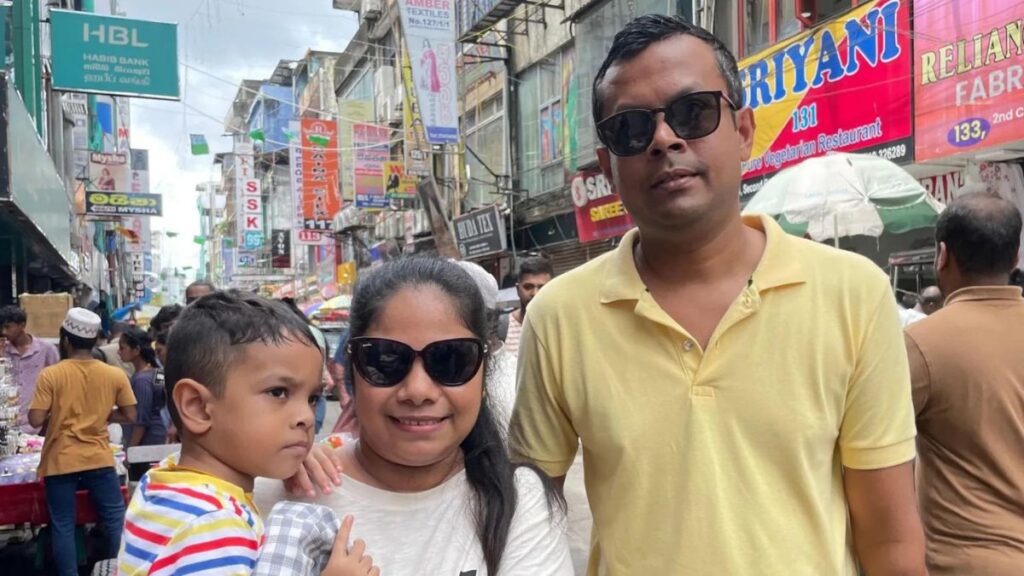
“Taxes are so high, we can’t manage,” says Rangika
Unlike past elections in Sri Lanka, the economy is front and centre in this one.
Holding her four-year-old son Nehan, Rangika Munasinghe laments the higher taxes she now pays.
“It’s very difficult. Salaries are being reduced, taxes on products and food are high. Kids meals, milk powder, all more expensive. Taxes are so high, we can’t manage it,” the 35-year-old told the BBC at a busy market in Colombo.
Sri Lanka was able to stave off bankruptcy in 2022 thanks to loans from the International Monetary Fund, and countries like China and India. But now everyone is feeling the pressure from the country’s enormous $92bn (£69bn) debt burden, which includes both foreign and national debt.
“I’m doing two jobs,” says Mohamed Rajabdeen, who’s in his 70s. He is selling spoons from a stall off a busy street. Once this is done, he will travel to his second job, working in security.
“We should get good salaries, university students should get jobs, and people should be able to live in peace and harmony. We expect our government to fulfil all of that.”
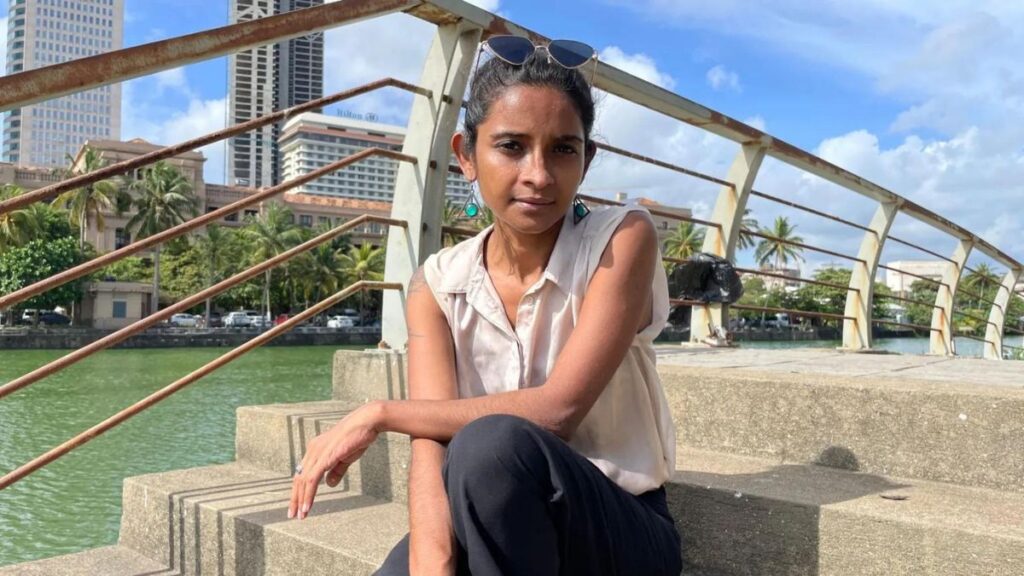
Activist Melani Gunathilaka says there has been a big change in society
Being that vocal about their expectations from elected officials is something new for many people in Sri Lanka. That change has been brought about by the protest movement, says Buwanaka Perera, a youth political activist.
“People are more gutsy in confronting the state or in confronting what’s wrong,” the 28-year-old said. “It’s not just the state, it’s trickled down to everyday things – it can be in your household, it can be in your streets. To make a stand to voice out and to look out for one another.”
Ms Brahmananayake agrees, calling it a lasting impact of her efforts and the thousands of others who participated in the uprising two years ago.
“People are talking about politics now. They are asking questions. I think people have the power in their hands. They can vote.”
Like her, climate and political activist Melani Gunathilaka, 37, knows the path forward will not be easy for Sri Lanka, but they have hope.
“There hasn’t been a change in the political and economic culture – but there has been a massive change in terms of society,” she says.
“For the first time people took charge, people exercised their democratic rights to do what’s right for the country.”
Who are the main candidates?
Ranil Wickremesinghe, a six-time former prime minister, was appointed president after Gotabaya Rajapaksa was ousted in 2022.
The 75-year-old, who faced the monumental task of trying to lead Sri Lanka out of economic collapse, has been accused of protecting the Rajapaksa family, allowing them to regroup, while shielding them from prosecution – allegations he has denied.
Anura Kumara Dissanayake is the candidate of the leftist National People’s Party alliance.
His promises of tough anti-corruption measures and good governance have boosted his candidacy, positioning the 55-year-old as a serious contender.
Sajith Premadasa, the runner-up last time, is the leader of the country’s main opposition Samagi Jana Balawegaya (SJB).
Earlier this week, he told news agency AP that he would ensure that the rich would pay more taxes and the poor would see their conditions improve if he won.
Namal Rajapaksa comes from a powerful political clan that produced two presidents.
The 38-year-old’s campaign has centred around the legacy of his father, who is still seen as a hero by some Sri Lankans for presiding over the bloody end to the civil war against Tamil Tiger rebels. But he needs to win over voters who blame the Rajapaksas for the economic crisis.
– Samira Hussain
(BBC News)
You may like
-
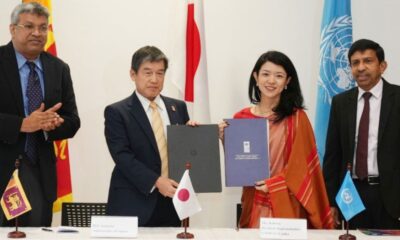

Japan grants US$ 2.5 mn. to SL to strengthen anti-corruption mechanisms
-


3 ex-DMT officials including ex-commissioner, remanded
-
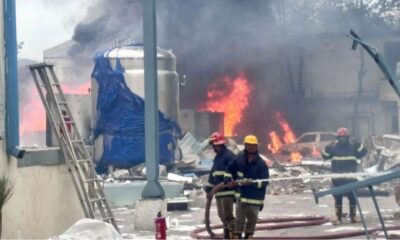

Death toll in India factory blast rises to 34
-


Ex-Immigration Controller pleads guilty
-
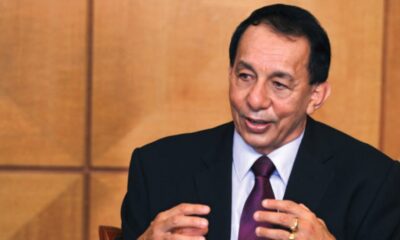

Nishantha Wickramasinghe remanded again (Update)
-
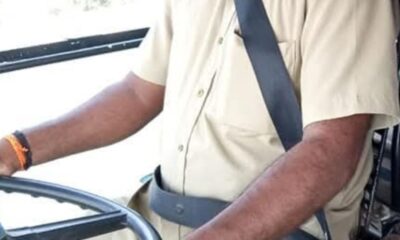

Seat belt compulsory for bus drivers from today
FEATURES
Asweddumized fields and sizzling kottu roti: New words from Sri Lanka
Published
5 days agoon
June 26, 2025By
editor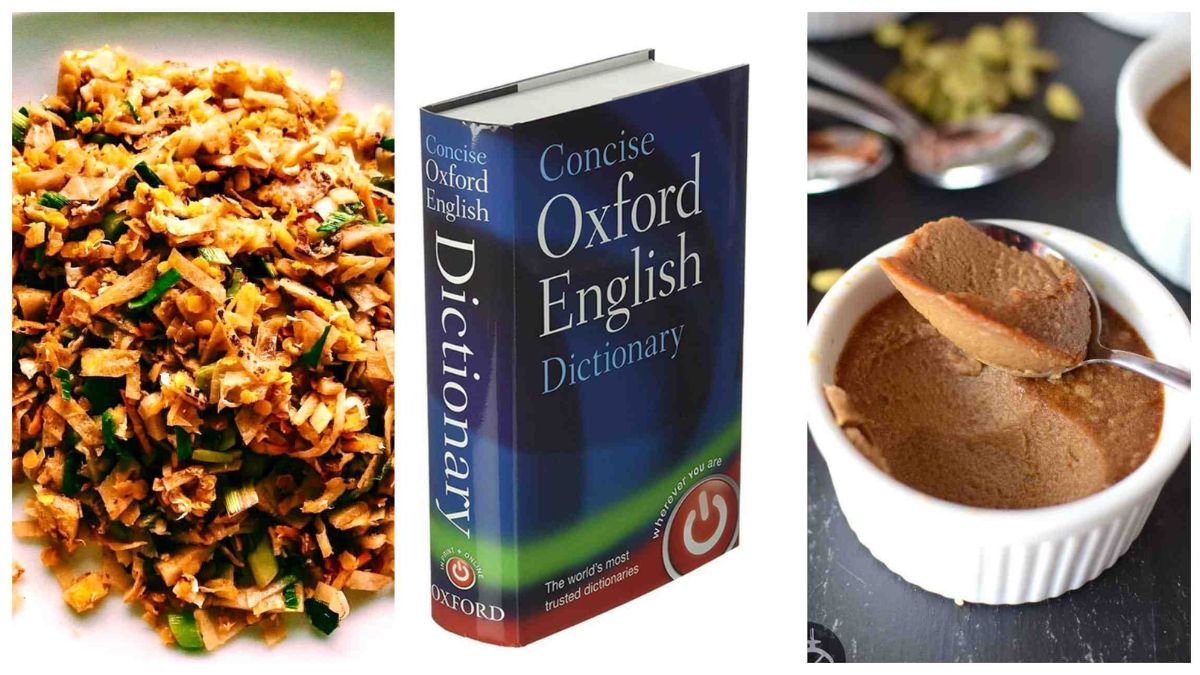
In a letter dated 7 October 1971 and sent from Panadura, Ceylon, OED contributor Pearl Cooray wrote to then Chief Editor Robert Burchfield: ‘I have looked up references for the word asweddumize and have succeeded to a certain extent. The Sinhala word aswedduma means “land recently converted into a paddy field”, and the Anglicized word asweddumize means to prepare a field for sowing paddy’. Cooray was a Sri Lankan academic who visited Burchfield in Oxford earlier in 1971, and upon returning to her country and her position in the Dictionary Department of the University of Ceylon, briefly corresponded with the OED, sending the above quoted letter as well as a selection of Sri Lankan newspapers and magazines for the reading programme for the OED Supplements that were in preparation at the time. Her suggestion for asweddumize would have been too late for the word to be considered for Volume I of the Supplements, so Burchfield wrote the word and definition on a paper slip, the main means by which words were tracked until the 2010s, and filed it alongside an earlier slip from July 1970 with the same suggestion from another Sri Lankan contributor, D. N. Ponnamperuma.
Nothing further is found about asweddumize in the OED’s files until 1986, when botanist D. J. Mabberley, a regular consultant for the Supplement, sent in a quotation slip for the word, which he would have encountered during the time he spent at a university in Sri Lanka. A decade later, another slip records the decision made not to draft an entry for asweddumize due to lack of evidence. ‘Omit (sadly)’was the responsible editor’s regretful note on the slip.
Almost thirty years later, this sad omission has finally been rectified, with the addition of asweddumize to the OED as part of this update. Current OED Sri Lankan English consultant Rochana Jayasinghe’s research on Pearl Cooray and her contributions to the Supplement helped put asweddumize back on the OED’s radar, and now that the dictionary’s editors have wider access to historical and contemporary Sri Lankan sources than their counterparts in the 1970s and 80s, it was possible to find sufficient evidence for the word, including a first quotation from as far back as 1857.
Joining asweddumize among this batch of new words are other borrowings from Sinhala, the Indo-Aryan language primarily spoken by the Sinhalese, the largest ethnic group in Sri Lanka. Mallung (first attested 1893) is lightly cooked, shredded (often leafy green) vegetables mixed with fresh grated coconut, chilli, and other spices, served as a side dish, salad, or condiment as part of a typical Sri Lankan meal, while kiribath (1886) is a Sri Lankan dish made with rice cooked in coconut milk and formed into a block, typically sliced into diamond-shaped pieces and served with various types of onion relish or sweetened with jaggery. Kiribath is traditionally eaten at special occasions such as Avurudu (1881), the first day of the Sinhala and Hindu New Year, occurring on the spring equinox (usually falling around 14 April), marked by a period of celebration typically lasting for seven to ten days.
Other Sri Lankan English words in this update originate both in Sinhala and another widely spoken language on the island, Tamil. Kottu roti (1991) is a Sri Lankan dish consisting of pieces of roti, meat, and vegetables, mixed with spices and curry sauce, and chopped by cleavers as they are cooked on a griddle. It is typically associated with the distinctive sound of the cleavers hitting the griddle as it is prepared by roadside vendors, and its name combines the Tamil word kottu ‘chopped’ with the Sinhala word roṭi ‘bread’. Partly a borrowing from Sinhala and partly a borrowing from Tamil, watalappam (1956) is a custard made from coconut milk (or sometimes condensed milk), cashew nuts, eggs, and spices such as cardamom and cloves, sweetened with jaggery and traditionally eaten by Sri Lankan Muslims during celebrations marking the end of Ramadan.
Sri Lankan music is represented by the words baila (1973) and papare (2006). Baila, a loan word from Portuguese, refers to an uptempo style of popular music originating in Sri Lanka which combines influences from both Africa and Europe, typically played in 6-8 time, with a syncopated rhythm, as well as to the style of dance performed to this music. Often associated with weddings and other celebrations, types of baila music are also popular in Goa and in the city of Mangaluru, on India’s west coast. Papare, on the other hand, is a genre of Sri Lankan music usually played at cricket and other sports matches, characterized by lively rhythms and typically featuring instrumentation of trumpet, saxophone, trombone, and snare and bass drums.
Apart from adding new Sri Lankan English words, OED editors have also revised a number of existing Sri Lankan English entries in the dictionary. Both these new and revised entries have been given transcriptions and audio pronunciations based on a new pronunciation model for Sri Lankan English, which is explained in more detail in this article. These enhancements to the OED’s coverage of Sri Lankan English help provide a more complete picture of how the language is used islandwide.
Full list of World English additions and revisions in the OED June 2025 update
(oed.com)
FEATURES
Dog-sized dinosaur that ran around feet of giants discovered
Published
6 days agoon
June 25, 2025By
editor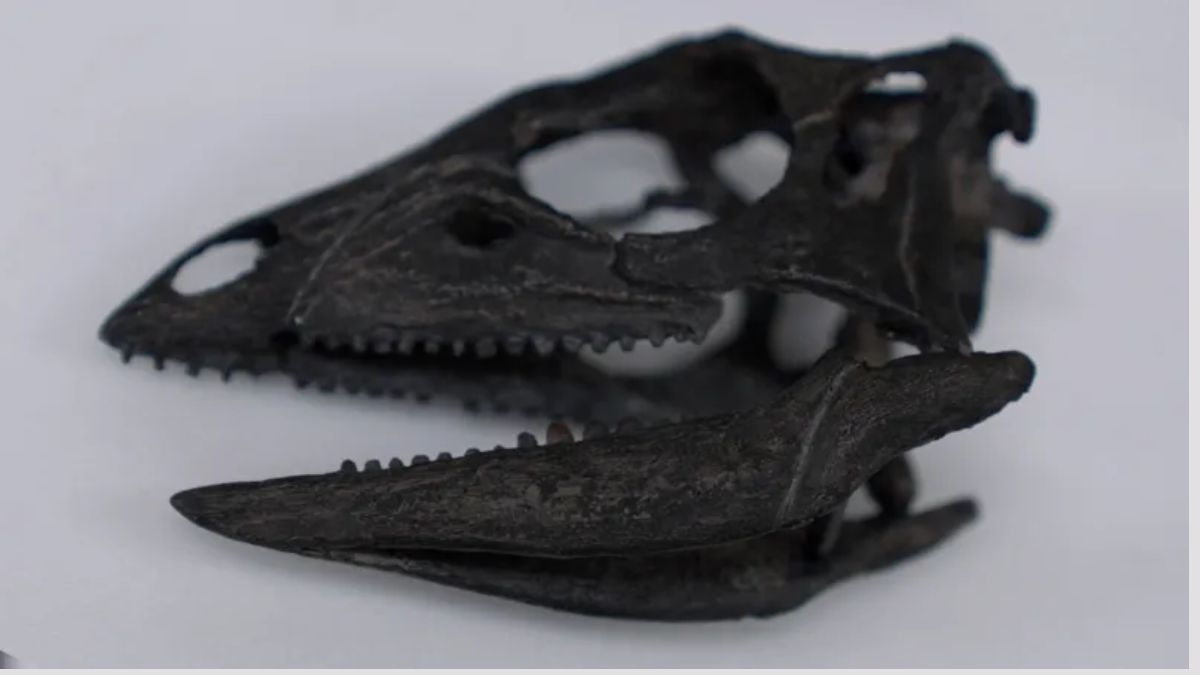
The full name of the new species is Enigmacursor mollyborthwickae dinosaur
A labrador-sized dinosaur was wrongly categorised when it was found and is actually a new species, scientists have discovered.
Its new name is Enigmacursor – meaning puzzling runner – and it lived about 150 million years ago, running around the feet of famous giants like the Stegosaurus.
It was originally classified as a Nanosaurus but scientists now conclude it is a different animal.
On Thursday it will become the first new dinosaur to go on display at the Natural History Museum (NHM) in London since 2014.
BBC News went behind the scenes to see the dinosaur before it will be revealed to the public.
The discovery promises to shed light on the evolutionary history that saw early small dinosaurs become very large and “bizarre” animals, according to Professor Paul Barrett, a palaeontologist at the museum.
When we visit, the designer of a special glass display case for the Enigmacursor is making last-minute checks.
The dinosaur’s new home is a balcony in the museum’s impressive Earth Hall. Below it is Steph the Stegosaurus who also lived in the Morrison Formation in the Western United States.
Enigmacursor is tiny by comparison. At 64 cm tall and 180 cm long it is about the height of a labrador, but with much bigger feet and a tail that was “probably longer than the rest of the dinosaur,” says Professor Susanna Maidment.

The Enigmacursor was a small dinosaur that lived alongside some of the biggest known
“It also had a relatively small head, so it was probably not the brightest,” she adds, adding that it was probably a teenager when it died.
With the fossilised remains of its bones in their hands, conservators Lu Allington-Jones and Kieran Miles expertly assemble the skeleton on to a metal frame.
“I don’t want to damage it at this stage before its revealed to everybody,” says Ms Allington-Jones, head of conservation.

Conservators Lu Allington-Jones and Kieran Miles assembled the dinosaur onto a frame for display
“Here you can see the solid dense hips showing you it was a fast-running dinosaur. But the front arms are much smaller and off the ground – perhaps it used them to shovel plants in its mouth with hands,” says Mr Miles.
It was clues in the bones that led scientists at NHM to conclude the creature was a new species.
“When we’re trying to identify if something is a new species, we’re looking for small differences with all of the other closely-related dinosaurs. The leg bones are really important in this one,” says Prof Maidment, holding the right hind limb of the Enigmacursor.
When the dinosaur was donated to the museum it was named Nanosaurus, like many other small dinosaurs named since the 1870s.
But the scientists suspected that categorisation was false.
To find out more, they travelled to the United States with scans of the skeleton and detailed photographs to see the original Nanosaurus that is considered the archtype specimen.
“But it didn’t have any bones. It’s just a rock with some impressions of bone in it. It could be any number of dinosaurs,” Professor Maidment said.

Susanna Maidment travelled to the US to look at the original Nanosaurus dinosaur
In contrast, the NHM’s specimen was a sophisticated and near-to-complete skeleton with unique features including its leg bones.
Untangling this mystery around the names and categorisation is essential, the palaeontologists say.
“It’s absolutely foundational to our work to understand how many species we actually have. If we’ve got that wrong, everything else falls apart,” says Prof Maidment.
The scientists have now formally erased the whole category of Nanosaurus.
They believe that other small dinosaur specimens from this period are probably also distinct species.
The discovery should help the scientists understand the diversity of dinosaurs in the Late Jurassic period.
Smaller dinosaurs are “very close to the origins of the large groups of dinosaurs that become much more prominent later on,” says Prof Barrett.
“Specimens like this help fill in some of those gaps in our knowledge, showing us how those changes occur gradually over time,” he adds.
Looking at these early creatures helps them identify “the pressures that finally led to the evolution of their more bizarre, gigantic descendants,” says Prof Barrett.

The fossilised remains are the most complete of any in the world for early small dinosaurs
The scientists are excited to have such a rare complete skeleton of a small dinosaur.
Traditionally, big dinosaur bones have been the biggest prize, so there has been less interest in digging out smaller fossils.
“When you’re looking for those very big dinosaurs, sometimes it’s easy to overlook the smaller ones living alongside them. But now I hope people will keep their eyes close to the ground looking for these little ones,” says Prof Barrett.
The findings about Enigmacursor mollyborthwickae are published in the journal Royal Society Open Science.
– Georgina Rannard
Science correspondent
(BBC News)
FEATURES
JVP-NPP should learn difference between “marine research” & “surveillance”
Published
1 week agoon
June 21, 2025By
editor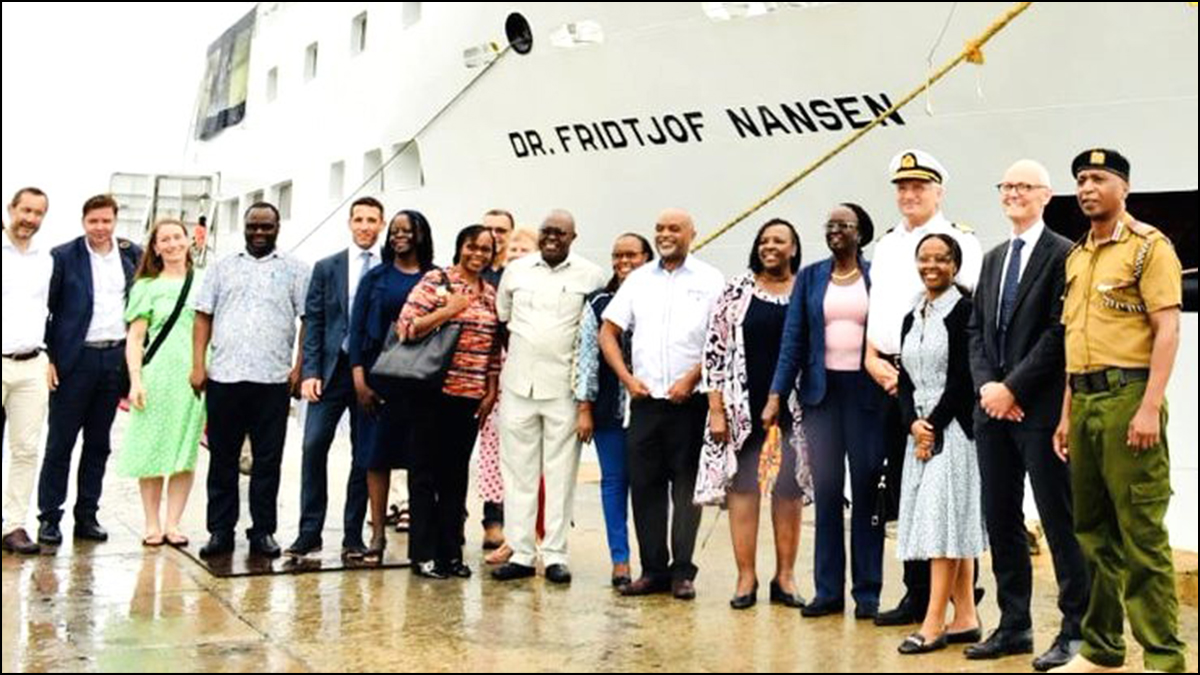
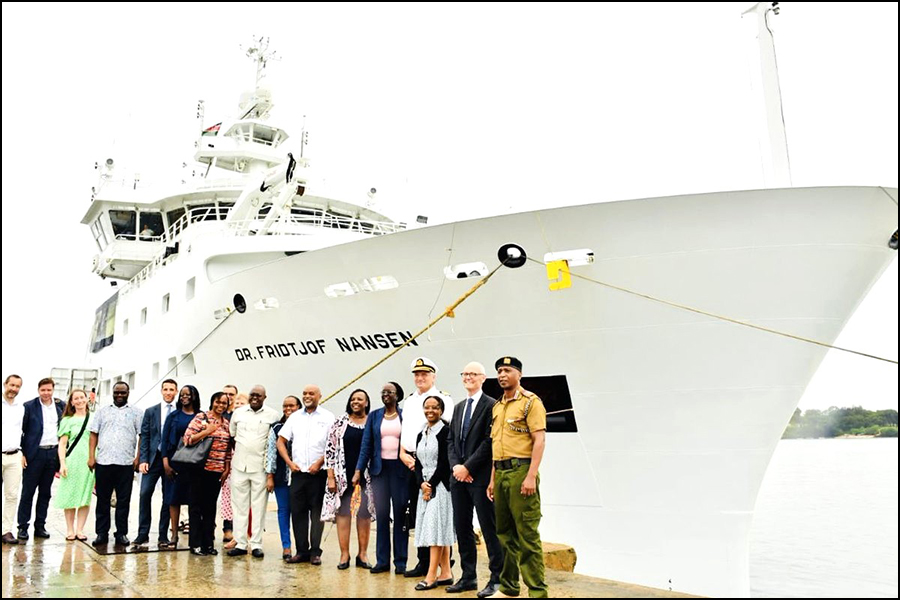
There’s now an apparent stand-off between the UN FAO and the Foreign Affairs Minister Vijitha Herath on the request made by the FAO to have permission for the UN flagged “Dr. Fridtjof Nansen” marine research vessel to enter Sri Lankan waters. Minister Herath is on record saying the request would have to wait till the Committee on Standard Operating Procedures (SOP) for foreign research vessels appointed by him and perhaps chaired by him too, complete their task in formulating the SOP. It was revealed, the SOP Committee is yet to be convened for the first time. With “Dr. Fridtjof Nansen” marine research vessel waiting in Mauritius to set sail to Sri Lanka, numerous discussions the UN had with the Foreign Ministry (FM) since April has only reached the point, where the SL FM agreed to allow the ship to pick Bangladeshi “Scientists” from Colombo, but not get involved in any research in our waters.
res (SOP) for foreign research vessels appointed by him and perhaps chaired by him too, complete their task in formulating the SOP. It was revealed, the SOP Committee is yet to be convened for the first time. With “Dr. Fridtjof Nansen” marine research vessel waiting in Mauritius to set sail to Sri Lanka, numerous discussions the UN had with the Foreign Ministry (FM) since April has only reached the point, where the SL FM agreed to allow the ship to pick Bangladeshi “Scientists” from Colombo, but not get involved in any research in our waters.
What’s this whole calamity over a FAO marine research ship requesting permission to enter Sri Lankan waters? Someone somewhere at the helm of the Foreign Ministry, or the Foreign Minister himself has wholly misinterpreted the issue of country owned research ships visiting Sri Lanka and the moratorium that was imposed by President Wickramasinghe barring foreign research ships.
Sri Lanka was pressured by India and the US to curtail if not stop Chinese research ships from docking in our ports in the past few years. Special concerns were over the 02 research ships “Yuan Wang 5” that docked at Hambantota in early 2022 during Gotabhaya’s presidency and “Shi Yan 6” in October 2023 at the Colombo port during Wickramasinghe’s presidency. It was said, these 02 research ships had the capacity for surveillance and monitoring the region. Under pressure especially from New Delhi, President Wickramasinghe decided to impose a one year moratorium on foreign research ships visiting Sri Lanka, effective from early January 2024.
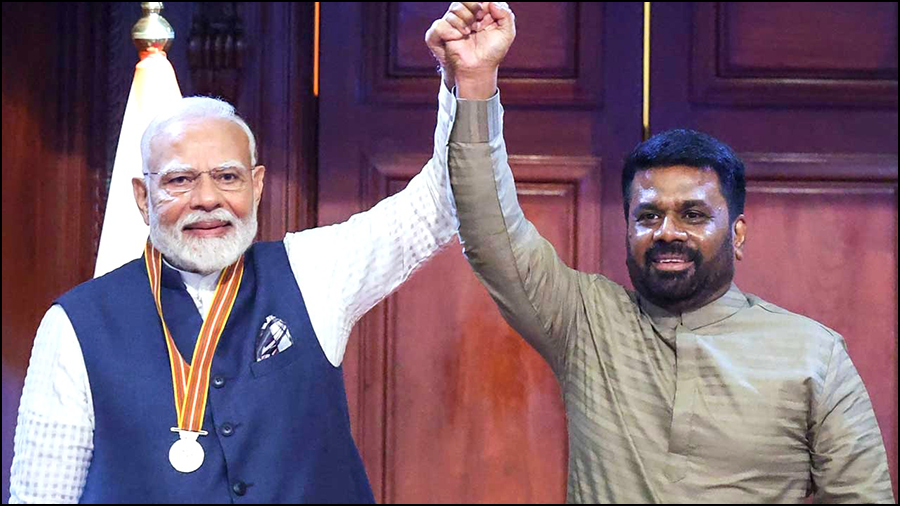
The Wickramasinghe moratorium came to its end on 05 January 2025, as the JVP-NPP government did not extend it further. Reason to allow the moratorium to lapse in January, may have been on a strictly confidential agreement reached to have a separate bi-lateral agreement on defence, during President Anura Kumara’s maiden official visit to India in mid-December 2024. Defence had been an issue discussed with Indian authorities during President Anura Kumara’s Indian visit, wrote Dr. Samatha Mallempati of “Indian Council of World Affairs” in May 2025. A defence MoU would thus make the moratorium irrelevant thereafter. PM Modi was to visit Sri Lanka 04 months later in early April this year. One among the many MoUs the 02 governments signed during PM Modi’s visit was the first ever Memorandum of Understanding (MoU) on “defence co-operation”.
India began working on a defence strategy for Indian Ocean Region (IOR) since the conclusion of Sri Lanka’s North-East civil war in 2009. New Delhi was very much concerned over President Rajapaksa’s post-war association with not only China, but with Pakistan too. Both with long time hostile border disputes with India. Contributing an article to “Stimson.org” on Pakistan-Sri Lanka relations in March 2021, two researchers on South & East Asian geo-politics Riaz Khokhar and Asma Khalid wrote, “In 2016, Pakistan signed a defense agreement with Sri Lanka to provide Colombo with eight JF-17 fighter aircrafts. Pakistani and Sri Lankan armies and naval forces have also regularly interacted through port calls, military and naval training and exercises, and defense workshops and seminars. In the recent high-level visit to Colombo, the Pakistani premier offered a USD $50 million credit line to Sri Lanka to further enhance defense and security partnerships.”
South Asian geo-politics did have new developments with post-war Sri Lanka compromising its economic needs with defence and national security in challenging the Tamil Diaspora canvassed US-Euro resolutions at UNHRC Sessions. Rajapaksa government was required to accept independent international investigations on war crimes and crimes against humanity, with many top military officers named. Pakistan stood with Sri Lanka, voting against all such resolutions at every UNHRC Session, while the Rajapaksa regime joined the Belt and Road Initiative of China, and was financially supported by China. Financial support that led to the popular adage “Sri Lankan type Chinese debt trap”.
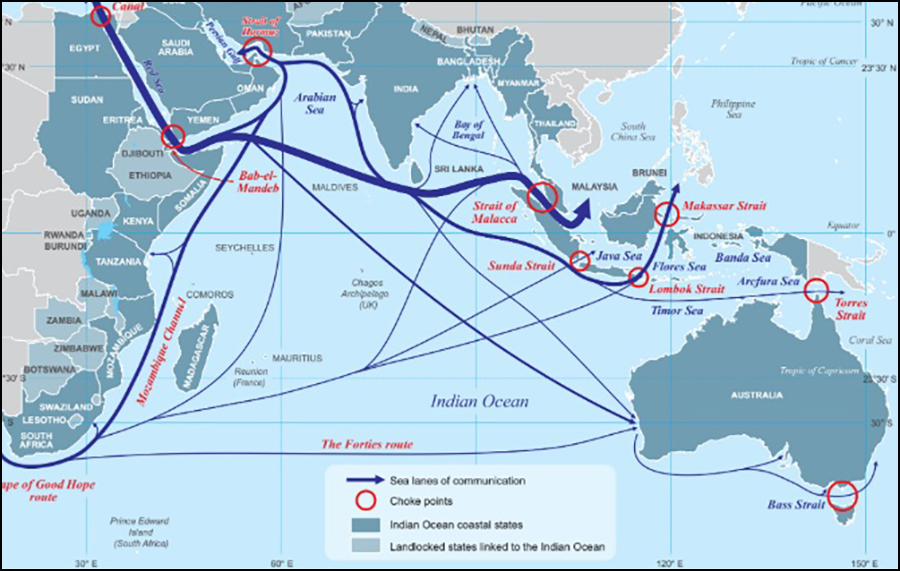
India has since been working towards establishing its dominance in the IOR keeping Sri Lanka as its focal point. Highlighting the geo-political importance of Sri Lanka, Dr. Samatha Mallempati wrote, “Since the region accounts for fifty percent of world maritime trade and seventy percent of global trade in oil and gas, there is a greater need to safeguard the sea lanes of communication. The increasing strategic significance of island states in the region therefore assumed importance. The island states such as Sri Lanka is looking to play a much bigger role by leveraging their geographical location.”
The perception in New Delhi that Sri Lanka is leveraging its geographical location to define geo-politics in the IOR, was what paved for the MoU on defence co-operation India signed with Sri Lanka, that for 05 years would provide India adequate space to influence Sri Lankan geo-politics in its favour. But the fact is, all these agreements and treaties are about IOR peace and stability and the influence “foreign countries” may have in it. The Sri Lankan moratorium was also about research ships of foreign countries, docking in our ports.
How would the UN flagged marine research ship “Dr. Fridtjof Nansen” interfere in IOR stability and peace? The request to FAO for marine research in our waters had gone from the SL Government, never mind who led the government. FAO is focussed on sustainable fisheries management and this modern, fully equipped ship for marine research is used mainly in African and Indian Ocean waters in collaboration with NORAD to support developing countries with research based fisheries management. That perhaps was the only reason for the previous government to request the FAO to visit Sri Lankan waters. Mind you, that request for FAO to undertake marine research in our waters, went out while the moratorium on foreign research ships was fully effective.
Whatever the bureaucracy at the FM says, a seasoned politician like Vijitha Herath who had been in parliament for 25 years to date from year 2000, should know the difference between this UN flagged marine research ship and other research ships owned by individual countries. Anything flagged as “UN” is common property of 195 sovereign nation States who are UN members. This ignorance therefore very clearly exhibits the JVP/NPP leadership as the most intellectually timid leadership to have been voted to power since 1948 independence.
Kusal Perera
20 June, 2025

Japan grants US$ 2.5 mn. to SL to strengthen anti-corruption mechanisms

3 ex-DMT officials including ex-commissioner, remanded

Death toll in India factory blast rises to 34
Trending
-
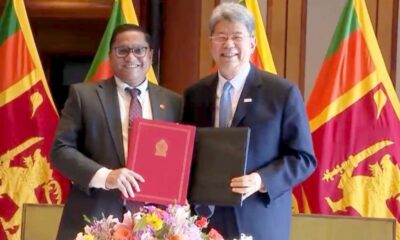
 BIZ2 days ago
BIZ2 days agoSri Lanka’s largest FDI project in limbo as Sinopec H’tota refinery face delays
-
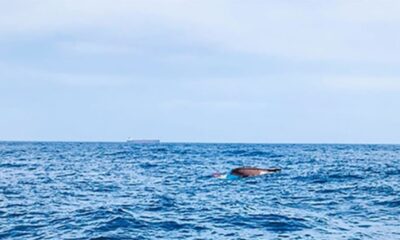
 News2 days ago
News2 days ago2 missing as fishing boat capsizes off Tangalle
-
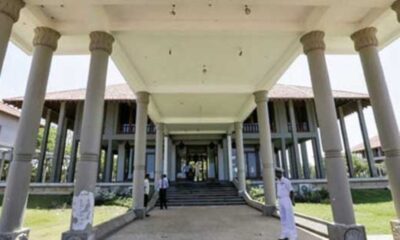
 News2 days ago
News2 days ago8 persons claim ownership rights to Jaffna’s Presidential Palace
-
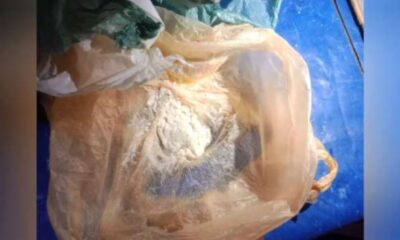
 News1 day ago
News1 day agoLorry carrying explosives seized on Habarana-Trinco road






